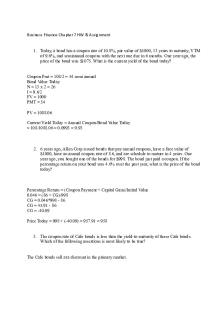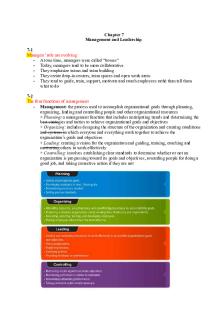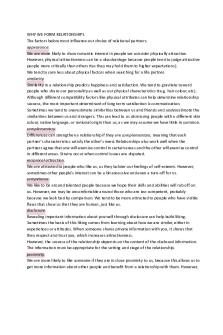Chapter 7 - Understanding Business PDF

| Title | Chapter 7 - Understanding Business |
|---|---|
| Course | Foundations Of Business I |
| Institution | Drexel University |
| Pages | 5 |
| File Size | 292.4 KB |
| File Type | |
| Total Downloads | 75 |
| Total Views | 144 |
Summary
This is the summary for the materials from chapter 7 in book, including main contents and key words definition....
Description
Chapter 7 Management and Leadership 7-1 Managers’ role are evolving - At one time, managers were called “bosses” - Today, managers tend to be more collaborative - They emphasize teams and team building - They create drop-in centers, team spaces and open work areas - They tend to guide, train, support, motivate and coach employees rathẻ than tell them what to do 7-2 The four functions of management - Management: the process used to accomplish organizational goals through planning, organizing, leading and controlling people and other organizational resources + Planning: a management function that includes anticipating trends and determining the best strategies and tactics to achieve organizational goals and objectives + Organizing: includes designing the structure of the organization and creating conditions and systems in which everyone and everything work together to achieve the organization’s goals and objectives + Leading: creating a vision for the organization and guiding, training, coaching and motivating others to work effectively + Controlling: involves establishing clear standards to determine whether or not an organization is progressing toward its goals and objectives, rewarding people for doing a good job, and taking corrective action if they are not
7-3 Planning and decision making - A vision: an encompassing explanation of why the organization and where it’s trying to head - Top management usually sets the vision for the organization and then often works with others in the firm to establish a mission statement - A mission statement: an outline of the fundamental purposes of an organization, its should address + The organization’s self-concept + Its philosophy + Long-term survival needs + Customer needs + Social responsibility + Nature of the product or service -
-
Goals: the broad, long-term accomplishments an organization wishes to attain Objectives: specific, short-term statements detailing how to achieve, the organization’s goals Several fundamental questions for planning: + What is the situation now? *SWOT analysis: a planning tool used to analyze an organization’s strengths, weaknesses, opportunities, and threats *Opportunities and threats are often external to the firm and cannot always be anticipated *Weaknesses and strengths are more often internal and therefore more within reach of being measured and fixed + How can we get to our goal from here? *It takes 4 forms: strategic, tactical, operational, and contingency Strategic planning: the process of determining the major goals of the organization and the policies and strategies for obtaining and using resources to achieve those goals Policies are broad guidelines for action, and strategies determine the best way to use resources
-
Tactical planning: the process of developing detailed, short-term statements about what is to be done, who is to do it, and how it is to be done
-
Operational planning: the process of setting work standards and schedules necessary to implement the company’s tactical objectives
-
Contingency planning: the process of preparing alternative courses of action that may be used if the primary plans don’t achieve the organization’s objectives
*Decision making: Finding the best alternative - Decision making: choosing among 2 or more alternatives - The rational decision-making model is a series of steps managers often follow to make logical, intelligent and well-founded decisions - 6 steps of decision making: 1. Define the situation 2. Describe and collect needed information
3. 4. 5. 6. -
Develop alternatives Decide which alternative is best Do what indicated (begin implementation) Determine whether the decision was a good one, and follow up
Problem solving: the process of solving the everyday problems that occur, Problem solving is less formal than decision making and usually as for quick action PMI: listing all the pluses for a solution in one column, all the minuses in another, and the implication in a third column
7-4 Organizing: creating a unified system - Top management: highest level of management, consisting of the president and other key company executives who develop strategic plans - Middle management: the level of management that includes general managers, division managers, and branch and plant managers who are responsible for tactical planning and controlling - Supervisor management: managers who are directly responsible for supervising workers and evaluating their daily performance
*Tasks and skills at different levels of management - Technical skills: skills that involve the ability to perform tasks in a specific discipline or department - Human relations skills: skills that involve communication and motivation, they enable managers to work through and with people - Conceptual skills: skills that involve the ability to picture the organization as a whole and the relationship among its various parts *Staffing: getting and keeping the right people - Staffing: a management function that include hiring, motivating, and retaining the best people available to accomplish the company’s objectives
7-5 Leading: providing continuous vision and values - Management is carrying out the leader’s vision, leaders must therefore + Communicate a vision and rally others around that vision + Establish corporate values + Promote corporate ethics + Embrace change + Stress accountability and responsibility - Transparency: the presentation of a company’s facts and figures in a way that is clear and apparent to all stakeholders *Leadership styles - Autocratic leadership: leadership style that involves making managerial decisions without consulting others - Participative (democratic) leadership: consists of managers and employees working together to make decisions - Free-rein leadership: involves managers setting objectives and employees being relatively free to do whatever it takes to accomplish those objectives *Empowering workers - Directing: leaders in the past gave explicit instructions to workers, telling them what to do to meat goals and objectives - Empowerment: giving employees the authority to make a decision without consulting the manager and the responsibility to respond quickly to customer requests - Enabling: giving workers the education and tools they need to make decisions *Managing knowledge - Knowledge management: finding the right information, keeping the information in a readily accessible place, and making the information known to everyone in the firm 7-6 Controlling: making sure it works Controlling process
-
External customers: dealers, who buy products to sell to others, and ultimate customers (or end users), who buy products for their own personal use Internal customers: individuals and units within the firm that receive services from other individuals or units...
Similar Free PDFs

Understanding business
- 11 Pages

Chapter 7 Business Marketing
- 34 Pages

Chapter 7 Business Ownership
- 5 Pages

Business Finance Chapter 7-9
- 12 Pages

Chapter 03 Understanding Buyers
- 13 Pages
Popular Institutions
- Tinajero National High School - Annex
- Politeknik Caltex Riau
- Yokohama City University
- SGT University
- University of Al-Qadisiyah
- Divine Word College of Vigan
- Techniek College Rotterdam
- Universidade de Santiago
- Universiti Teknologi MARA Cawangan Johor Kampus Pasir Gudang
- Poltekkes Kemenkes Yogyakarta
- Baguio City National High School
- Colegio san marcos
- preparatoria uno
- Centro de Bachillerato Tecnológico Industrial y de Servicios No. 107
- Dalian Maritime University
- Quang Trung Secondary School
- Colegio Tecnológico en Informática
- Corporación Regional de Educación Superior
- Grupo CEDVA
- Dar Al Uloom University
- Centro de Estudios Preuniversitarios de la Universidad Nacional de Ingeniería
- 上智大学
- Aakash International School, Nuna Majara
- San Felipe Neri Catholic School
- Kang Chiao International School - New Taipei City
- Misamis Occidental National High School
- Institución Educativa Escuela Normal Juan Ladrilleros
- Kolehiyo ng Pantukan
- Batanes State College
- Instituto Continental
- Sekolah Menengah Kejuruan Kesehatan Kaltara (Tarakan)
- Colegio de La Inmaculada Concepcion - Cebu










